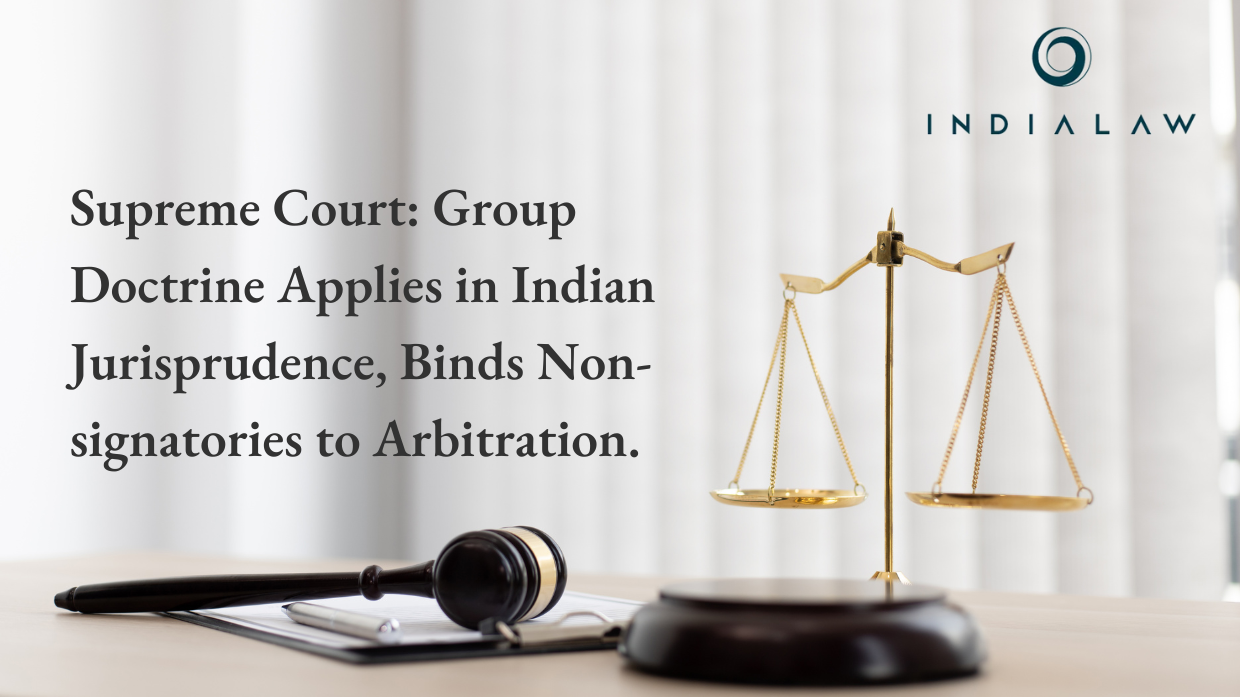Group of Companies Doctrine Applies to Indian Jurisprudence; Can Also Bind non-signatories to Arbitration Agreement: Supreme Court

A Constitution Bench comprising of Dr. Dhananjaya Y. Chandrachud (CJI), Justice Hrishikesh Roy, Justice Pamidighantam, Sri Narasimha, Justice J.B. Pardiwala and Justice Manoj Misra, of the Supreme Court (“SC”) held in the case of Cox and Kings Ltd v. SAP India Pvt Ltd. i that an arbitration agreement can bind non-signatories through “group of companies” doctrine.
The SC concluded that “The ‘group of companies’ doctrine must be retained in the Indian arbitration jurisprudence considering its utility in determining the intention of the parties in the context of complex transactions involving multiple parties and multiple agreements”.
It highlighted that the principle of “alter ego” or “piercing the corporate veil” cannot form basis to trigger ‘group of companies’ doctrine. Explaining it further the SC stated “The principle of alter ego disregards the corporate separateness and the intentions of the parties in view of the overriding considerations of equity and good faith. In contrast, the group of companies doctrine facilitates the identification of the intention of the parties to determine the true parties to the arbitration agreement without disturbing the legal personality of the entity in question”.
Group of Companies Doctrine
For ease of readers, the doctrine provides that an arbitration agreement which is entered into by a company within a group of companies may bind non-signatory affiliates, if the circumstances are such as to demonstrate the mutual intention of the parties to bind both signatories and non-signatories.
Brief facts
Cox and Kings Ltd. (‘Petitioner’) is in the business of tours and travel services. SAP SE GMBH (Respondent 2) was a European multinational software company that was incorporated under German laws.
The Petitioner and Respondent 2 had entered an SAP Software End User License Agreement (‘License Agreement’) dated 14-12-2010. Respondent 2 was the proprietor and licensor of the software. SAP India Private Ltd. (Respondent 1) was its licensee in India, and it was a subsidiary of Respondent 2.
The License Agreement signed between the Petitioner and Respondent 2 recorded that the said software was owned by Respondent 2 and Respondent 1 was only a licensee. The Agreement created an interlink between respondents 1 and 2 while providing services to the Petitioner.
Case of the Petitioner
The Petitioner claimed that due to the delay in the execution of the project by Respondent 1, it had to face serious prejudice. When no response was received from Respondent 1, the matter was escalated to Respondent 2, and several issues were brought to the notice of Respondent 2, further it was asked to get the project on track.
Assurance was given by Respondent 2 to the Petitioner that it would monitor the project and revise the project’s delivery approach.
The Petitioner placed reliance on the decision of Chloro Controls India Private Limited v. Severn Trent Water Purification [i]. It averred that the “Group of Companies” Doctrine would be applicable here, as an Arbitration Agreement entered by Respondent 1 can also bind Respondent 2 even though it was a non-signatory but Respondents 1 and 2 constitute a ‘group of companies’.
Three Judges SC Bench Decision referred to Five Judges Bench
The three Judges Bench noted that the ‘Group of Companies Doctrine’ had been applied in several cases after the Chloro Controls (Supra) decision. The bench stated that this doctrine should be applied with due care and caution.
It added that merely because a non-signatory party is a member of a group of affiliated companies it would not be sufficient to extend the scope of the arbitration agreement to the non-signatory party.
Doubting the correctness of the decision in Chloro Controls (Supra), the SC 3-Judges bench referred to the interpretation of ‘claiming through or under’ under Section 8 of the Arbitration and Conciliation Act, 1996 (Arbitration Act) about the ‘doctrine of group of companies’ to the Constitution Bench of five Judges.
Issues before the Constitutional Bench
- Whether the Doctrine of Group of Companies exist in Indian jurisprudence?
- Can the Doctrine be read in consonance with Section 8 of the Arbitration Act?
- Whether the Doctrine of Group of Companies be construed to interpret the implied consent to arbitrate between the non-signatory party also?
Findings of the SC
The SC concluded that there is no mandate that the arbitration agreement would only bind the signatories. To have a written arbitration agreement would not bar to bind non-signatories, if there exists a legal relationship between a signatory and a non-signatory party, and if there is an intent via conduct to be bound, it will bind a non-signatory party also.
CJI stated that “The signature of the party in the agreement is the most profound expression of consent of the person to submit to jurisdiction. However, the corollary that persons who have not signed aren’t part of the agreement may not always be correct.”
The SC highlighted that a non-signatory to arbitration agreement binds itself through its relationship with the signatory party and commercial involvement in the subject matter.
Constitutional Bench Decision
The bench conclusively concluded that:
- The definition of the term ‘parties’ under Section 2(1)(h) read with Section 7 of the Arbitration Act is inclusive of signatory and non-signatory parties.
- The legal relationship between the signatory/non-signatory party and the conduct of the non-signatory party is an indicator of the consent to bind a non-signatory party.
- The requirement of a written arbitration agreement under Section 7 of the Arbitration Act does not exclude the possibility of binding non-signatory parties.
- There is a difference under the Arbitration Act between the expression ‘party’ and a ‘person claiming through or under a party’ to the arbitration agreement. The expression “claiming through or under” in Sections 8 and 45 of the Arbitration Act is intended to provide a derivative right. It does not enable a non-signatory to become a party to the arbitration agreement.
- The ‘doctrine of a group of companies’ does not affect the separate identity of different companies; application of doctrine is based on the conduct of non-signatories, indicating through its conduct to be bound by the arbitration agreement.
- The principle of ‘alter ego’ and the principle of corporate law of ‘piercing the corporate veil’ hold no basis to attract the doctrine.
- The doctrine exists separately as a legal principle generated through harmonious reading of Section 2(1)(h) along with Section 7 of the Arbitration Act.
- The Courts and Tribunals must consider all the factors laid down in ONGC Ltd. v. Discovery Enterprises (P) Ltd.iii, while applying the doctrine. The principle of the same group of companies operating as a single economic unit would not be the sole base to invoke the doctrine.
- The persons claiming “through or under” can only assert rights in a derivative capacity.
- The decision in Chloro Controls (Supra) is erroneous to the extent that the ‘doctrine of a group of companies’ applies to ‘claiming through or under’ as per Section 8 of the Arbitration Act, it is against the principles of contract in commercial law.
- The doctrine needs to be retained in Indian Arbitration Jurisprudence due to its utility and determining the intention of the parties about complex transactions with several parties and agreements.
Conclusion
The Group of Companies doctrine must also be ascertained based on the intention of the non-signatory to be party to an arbitration agreement. The intention must be gathered from various factors including direct relationship with the signatory parties, negotiation, performance, commonality of subject-matter, composite nature of the transaction, etc. The participation of non-signatory parties in all these activities would be considered as its implied consent to be bound by the agreement.
[i] (2013) 1 SCC 641
By entering the email address you agree to our Privacy Policy.



